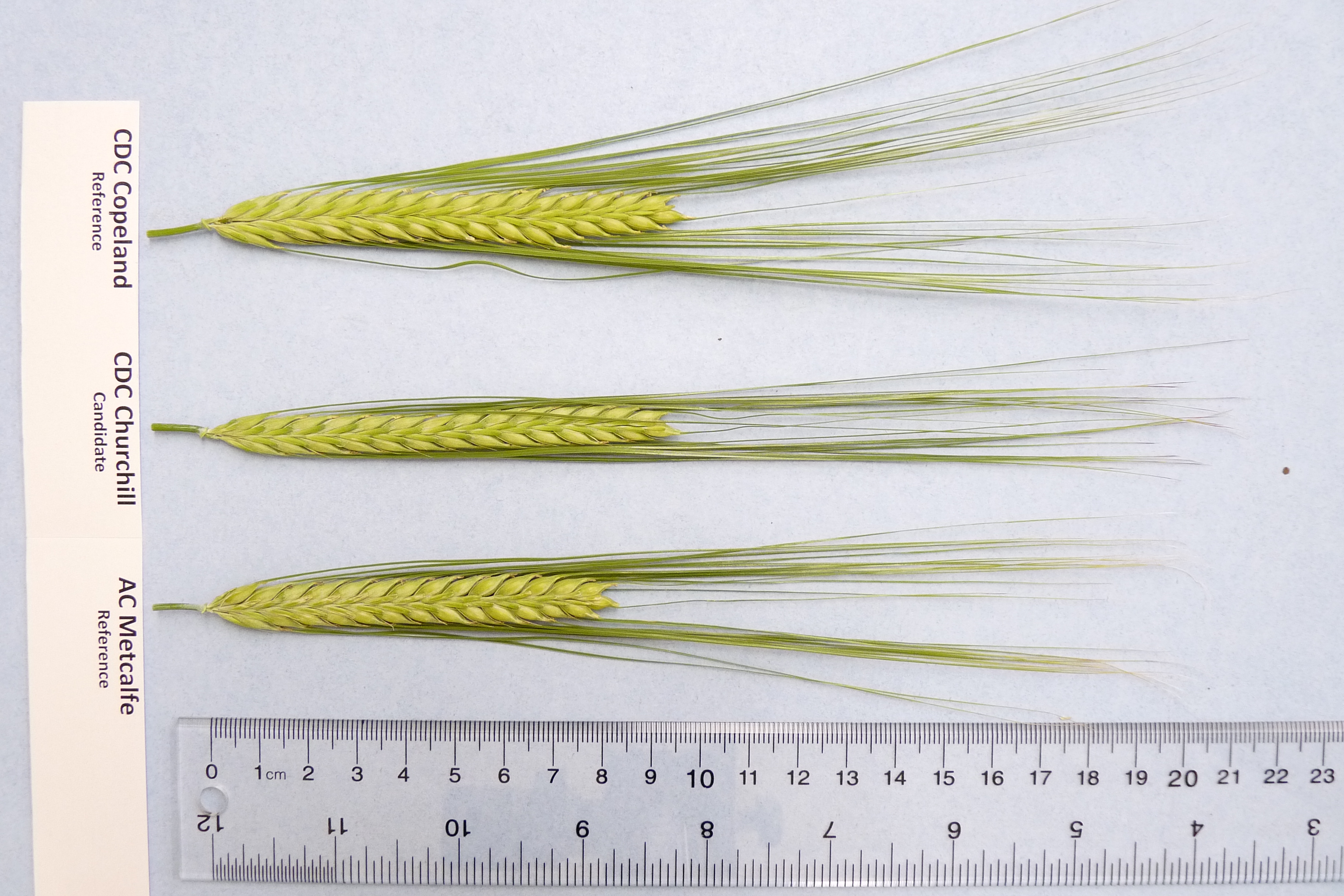CDC Churchill
| Denomination: | 'CDC Churchill' |
|---|---|
| Botanical Name: | Hordeum vulgare |
| Applicant/Holder: |
University of Saskatchewan Crop Development Centre 4D36 Agriculture Building, 51 Campus Drive Saskatoon, Saskatchewan S7N 5A8 Canada |
| Breeder: |
Aaron Beattie, University of Saskatchewan, Saskatoon, Saskatchewan |
| Application Date: | 2019-04-17 |
| Provisional Protection:: | 2019-04-17 |
| Application Number: | 19-9769 |
| Grant of Rights Date: | 2021-03-19 |
| Certificate Number: | 6401 |
| Grant of Rights Termination Date: | 2041-03-19 |
Variety Description
Varieties used for comparison: 'CDC Copeland' and 'AC Metcalfe'
Summary: At booting, the flag leaf of 'CDC Churchill' is longer than the flag leaf of 'CDC Copeland'. At the beginning of ripening, the plants of 'CDC Churchill' are shorter than those of both reference varieties. The spike attitude of 'CDC Churchill' is erect whereas the spike attitude of both reference varieties is semi-erect. The curvature on the first segment of the rachis for 'CDC Churchill' is medium whereas the curvature on both reference varieties is absent or very weak to weak.
Description:
YOUNG PLANT: semi-erect growth habit at tillering, sparse pubescence on lower leaf sheaths
PLANT: two row, spring malting barley, medium to high frequency of plants with recurved flag leaves, spike emergence occurs mid-season
FLAG LEAF (AT BOOTING): sparse pubescence on blade
FLAG LEAF SHEATH: strong glaucosity, sparse pubescence
AURICLES: weak to medium intensity of anthocyanin colouration, sparse pubescence on margins
SPIKE: medium glaucosity, erect attitude, platform and cup shaped collar, parallel shape, lax density, parallel to weakly divergent sterile spikelet, glume and awn of the median spikelet are equal to length of grain
LEMMA AWNS: very weak to weak intensity of anthocyanin colouration of tips, longer than length of spike, rough spiculations on margins
FIRST SEGMENT OF RACHIS: medium length, medium curvature
KERNEL: whitish aleurone layer, long rachilla hairs, husk present, absent or very weak anthocyanin colouration of nerves of lemma, medium spiculation of inner lateral nerves of dorsal side of lemma, hairiness of ventral furrow absent, clasping disposition of lodicules, horseshoe to incomplete horseshoe shaped basal markings, medium length and width
AGRONOMIC CHARACTERISTICS: good resistance to lodging and shattering, good tolerance to straw breakage, fair to good tolerance to drought, good malting quality
DISEASE REACTION: moderately susceptible to True Loose Smut (Ustilago nuda)
Origin & Breeding History: 'CDC Churchill (experimental designations TR15155 and SM121588) originated from the cross between TR08116 and TR07299 made under glass greenhouse at the Crop Development Centre at the University of Saskatchewan in Saskatoon in 2008 using a modified bulk breeding system. The F1 to F3 generations were grown as bulk populations in a winter nursery New Zealand and concurrently in a nursery in Saskatoon from 2008 to 2009. In 2010, the F4 population was space planted in Saskatoon. The subsequent F5 generation was grown in hill plots and select plants were harvested and bulked to produce the line designated SM121588. SM121588 was tested in preliminary OR Crop Development Centre yield trials from 2012 to 2014 followed by testing as TR15155 in the Western Cooperative Two-Row Barley Registration Trials. TR15155 was further tested in the Collaborative Barley Trials from 2016 to 2017. Selection criteria included yield, plant height, resistance to disease, lodging resistance, as well as grain protein content and malting properties.
Tests & Trials: The comparative trials for 'CDC Churchill' were conducted at the University of Saskatchewan Crop Science Field Laboratory in Saskatoon, Saskatchewan during the 2018 and 2019 growing seasons. The trials were arranged in a RCB design with 4 replicates. Each 4.5 metre squared plot consisted of 5 rows 3.66 metres in length with a row spacing of 0.2 metres. The planting density was 215 plants per square metre. Measured characteristics were based on a minimum of 24 measurements in 2018 and 48 measurements in 2019. The mean differences were significant at the 5% probability level based on LSD values.
Comparison tables for 'CDC Churchill' with reference varieties 'CDC Copeland' and 'AC Metcalfe'
PFlag leaf length (cm)
| 'CDC Churchill' | 'CDC Copeland' | 'AC Metcalfe' | |
|---|---|---|---|
| mean 2018 (LSD=0.53) | 9.04 | 8.17 | 9.38 |
| std. deviation 2018 | 1.04 | 0.87 | 0.82 |
| mean 2019 (LSD=0.70) | 10.4 | 9.5 | 9.5 |
| std. deviation 2019 | 1.6 | 1.5 | 1.9 |
Plant height (cm)
| 'CDC Churchill' | 'CDC Copeland' | 'AC Metcalfe' | |
|---|---|---|---|
| mean 2018 (LSD=1.0) | 65 | 69 | 68 |
| std. deviation 2018 | 3.6 | 4.8 | 4.1 |
| mean 2019 (LSD=1.0) | 72 | 79 | 76 |
| std. deviation 2019 | 2.2 | 3.2 | 2.1 |
Click on image for larger view

Barley: 'CDC Churchill' (centre) with reference varieties 'AAC Metcalfe' (left) and 'CDC Copeland' (right)
Click on image for larger view

Barley: 'CDC Churchill' (centre) with reference varieties 'CDC Copeland' (left) and 'AAC Metcalfe' (right)
- Date modified: